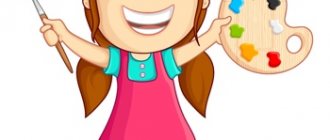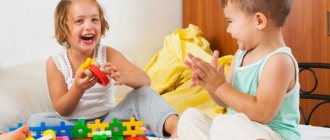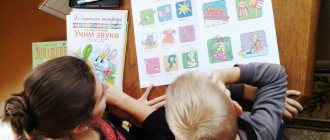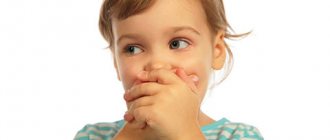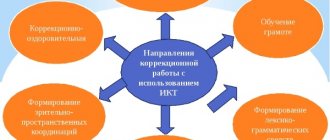General underdevelopment of speech, or GSD, is a systemic disorder of speech activity in which its semantic and sound components - phonetics, vocabulary and grammar - are incorrectly formed.
Until the age of 3–4 years, children “have the right” to speak as they can and want. But if your son or daughter, even after reaching this age, does not fully use speech as a means of communication, you should consult a doctor - a neurologist or speech therapist. If there is a problem, it is better to diagnose it in preschool age and teach the child to speak correctly. Otherwise, in the future, OPD promises him big problems in social and personal terms: difficulties in mastering writing and reading, the school curriculum as a whole, retardation in mental and mental development, personality disorders.
What does OHP mean and its symptoms?
Here are general signs that may indicate underdevelopment of speech in a child:
- said the first words at 3–4 years old, and in more severe cases at 5 years old;
- speaks illiterately, incoherently and incomprehensibly, the phonetic design of speech is low;
- The baby understands the words addressed to him, but cannot fully express his thoughts.
Depending on the severity of OHP, it is divided into 4 levels.
Level 1 violation is the most severe. The child either does not speak at all or speaks individual sounds or syllables.
With a level 2 illness, the baby, although he speaks at an everyday level, is illiterate, pronounces sounds incorrectly, and his vocabulary is small.
With speech underdevelopment of the 3rd level, the child has developed phrasal speech, but there is lexico-grammatical and phonetic underdevelopment.
The easiest is level 4. The baby communicates fully verbally, but there are still some problems.
Next, we’ll talk about the characteristics of each level of OHP in children in more detail.
Diagnostics of speech development of 2-3 year old children
It is easier for parents to evaluate the development of their own child by comparing him with his peers. But this is an erroneous approach, since each child has his own speed of learning the world, which is most convenient for him. To know whether the child’s level of development meets the norms, you need to compare it with the fact that at two or three years old a child should be able to:
- Understand simple sentences, questions and requests on everyday topics.
- Say hello and goodbye.
- Make sentences of 2-4 words.
- Memorize new words from songs and short rhymes.
- Formulate simple requests (for hands, for a drink, for a potty).
Degrees of speech underdevelopment and their characteristics
Depending on the depth of the lesion, OHP can manifest itself in different ways - from minor deviations to complete absence of speech.
Level 1: speech is practically absent
You don’t need to be a doctor to notice problems with speech development in a child. He uses babble, sounds, the first syllables of words. He speaks his “own” language; one word can mean several things.
Instead of words, the baby actively expresses his thoughts and desires with gestures and facial expressions, and is always appropriate and correct.
The child does not speak in simple sentences; at best, he uses two amorphous words, for example, “woof bee-bee” - the dog is driving a car.
The passive vocabulary is well developed - the baby understands speech addressed to him. But the active vocabulary is poor, phonemic hearing is not developed - the child cannot pronounce words that consist of several syllables, and says them in his own way: “abas” instead of “bus,” for example.
Level 2: presence of commonly used words
This is the main characteristic of speech underdevelopment of this degree. There are words in speech, although there are not very many of them and the child pronounces them incorrectly. But a grammatical connection between words is already beginning to form.
The kid distorts the name of a certain object, and everywhere. For example, instead of “apple” he says “lyabako”.
The child does not know the shapes, parts of objects, and cannot combine them into groups (dishes, toys, clothes).
The baby pronounces most sounds incorrectly, does not coordinate words in simple sentences, often misses prepositions, and shortens words of several syllables.
But in simple sentences he can correctly name objects and their actions in the plural (for example, goes - go). If you ask your baby to tell you what he sees in the picture, he may come up with a coherent story, albeit a very limited one.
Level 3: violation of grammar and phonetics
The child has a large active vocabulary; he speaks in detailed sentences, but the development of the grammatical and phonemic components of speech suffers.
Parents understand the baby well, but when communicating with others they need a “translator”. The baby pronounces isolated sounds well, but his speech is still unclear. If it is difficult for him to pronounce a sound, he replaces it with an easier one. This is especially true for affricates, whistling, sonorant and hissing sounds.
Complex and complex sentences still cause difficulties, but the child is confidently moving towards success. But little-used vocabulary is still inaccessible to him - in his speech he uses words of everyday meaning that he constantly hears around.
The child constructs phrases and can compose a story, although he still forms sentences with errors. But errors in word agreement do not occur all the time. More often, the child makes mistakes when coordinating nouns and numerals: “many cats - many cats.”
He does not always pronounce complex words correctly; he cannot name words that begin with a specific letter.
Level 4: practically a variant of the norm
Speech underdevelopment is not noticeable, but taken together the symptoms make it difficult for the child to study at school - it is more difficult for him to learn to write and read. Therefore, it is imperative to eliminate the symptoms of OHP. Although this form of disorder is quite rare.
The child periodically pronounces complex words incorrectly - skips syllables, replaces or swaps sounds.
Articulation and diction suffer - speech is unclear, slightly slurred, and the child does not always use words as intended, because he does not understand or confuses their meanings. This is especially true for the characteristics of objects (for example, tall - long, low - short).
Another problem area is the formation of words using a suffix; errors remain in the agreement of nouns and adjectives and the plural.
Critical thinking is developed: if a child is given two answer options, he will choose the correct one.
Exercises for speech development
"Pipe and Whistle"
The child is surrounded by a world of various sounds. If you knock on this little thing, you will get one sound, but if you blow on this pipe, then a completely different sound will come out. When making sounds, the baby simultaneously trains breathing and learns the cause-and-effect relationship (blowed into a pipe - received a sound). It's best to start with a simple whistle because you just need to blow into it to get the sound out. For older children, you can use a pipe, which complicates the task and thereby makes it more entertaining and interesting for the baby.
"Wash"
It is best to do this exercise while washing your face in the morning, taking advantage of the kids’ favorite pastime - making faces in front of the mirror. You need to ask the baby, with his lips stretched out, to say “o”, “vo”, “mo”. Just 2-3 minutes is enough for this exercise.
"Who's next?"
The rules here are very simple: whoever lasts any vowel sound longer. You can also draw out some consonants. Children love to play this game with their parents.
"Repeat after me"
The game develops the articulatory apparatus and forms correct pronunciation. You need to read short rhymes to the baby, and he must repeat the last syllable after the adult. The kids came running - ra-ra-ra, ra-ra-ra. Leg higher, step bolder - ley-lay-lay, ley-lay-lay. We will see the leaves fall - pad-pad-pad, pad-pad-pad. Dear bunny, don’t be bored - tea-tea-tea, tea-tea-tea.
"Show off the bear"
The game develops speech and teaches how to navigate in space. It will require a soft toy (in this case, a bear). An adult should take the bear in his hands and in his voice tell the baby that he would really like to get to know the place where the baby’s family lives. Then you need to ask the child to take the bear around the house and show him all the interesting places. You can start from the kitchen, where the baby should “take” the toy. Using the voice of a toy, an adult should ask what the names of kitchen utensils and furnishings are, and with his paw point to the table, stove, refrigerator, etc. The bear should ask why they are needed, and the baby should answer these questions. Then you can go around the other rooms.
"More words"
The game helps develop speech and teaches how to compose long words. Together with your child, you need to try to indicate the property or sign of an object in one word. For example, if dad has brown eyes, then he is brown-eyed, and if a bunny has long ears, then he is long-eared.
"Guess the Animal"
The game develops the articulatory apparatus, speech, and introduces the baby to the world of animals. It will require cards with images of animals and a friendly company. Mix the inverted cards and place them on the table. Each player takes out a card in turn and voices the animal depicted there, while the rest must guess who he was describing.
"Finish the word"
The game develops attention, memory and speech. You need to ask the child to complete the word spoken by the adult: “magazin”, “dorog-ga”, “kolo-bok”. If the baby doesn’t guess, then you can point him to the named object.
"Animal Voices"
This game develops articulation, speech and introduces the animal world. You need to prepare animal toys or cards with their images. The child needs to be shown toys or cards and allowed to look at them carefully, while telling him where the animal lives and what it eats, and what sounds it makes. It would be great to take your child to the zoo or use recordings of animal voices. Then you can conduct the final lesson. When the child sees the card, he is asked to name the animal depicted and remember the sounds it makes:
- rooster - crows (crow);
- goose - cackling (ha-ha-ha);
- duck - quacks (quack-quack);
- turkey - kuldyk (kuldy-kuldy);
- crow - croaks (kar-kar);
- sparrow - tweets (tweet-tweet);
- eagle owl - hoots (hoo-hoo);
- cat - meows (meow-meow);
- dog - barks (woof-woof);
- goat - bleats (me-e-e);
- wild boars, pigs - grunt (oink-oink);
- cow - moos (moo-oo);
- horse - neighs (e-go-go);
- donkey - brays (ey-ey);
- mouse - squeaks (pi-pi-pi);
- frog - croaks (kva-kva);
- tiger, lion - roars (r-r-r);
- elephant - trumpets (tu-u-u);
- bee - buzzing (w-w-w).
You should not ask your child about all animals at once.
"My phone rang"
The game replenishes vocabulary and develops speech. It simulates a conversation on the phone, the function of which can be performed by any object, for example, a piece from a designer, a stick, a cube. The parent and child should take turns pretending to be talking on the phone. The elder asks simple questions on his own behalf, and the child answers. Then they change roles. You can also talk to your baby on behalf of the animal or toy.
Reasons for the development of OHP in children
Speech development disorders can have different causes. Let's highlight the following groups:
- Intrauterine development. Infections in the mother during pregnancy, toxicosis;
- Complicated childbirth. Injuries during childbirth, various pathologies;
- Health status of the newborn. Diseases of the central nervous system and traumatic brain injury in infancy can also cause the development of OHP;
- Social factors. Unfavorable family environment. For example, parents did not work with the baby, did not teach, did not develop.
In some cases, OHP in children develops against the background of intellectual or hearing impairments.
When to see a speech therapist
You should contact a speech therapist if:
• up to 2.5 years the child has not developed speech or the child’s vocabulary is no more than 10 words. A qualified speech therapist can not only correct sound pronunciation, but also stimulate the appearance of speech in non-speaking children;
• a child of 1.5 - 2.5 years old does not utter normal, understandable words like “mother”, “woman”, “bi-bi”, “cat”, “drink”, “go”, but speaks in his own language language, and a lot and actively (no need to wait 3 years - go to a speech therapist right now);
• a child of 4 – 5 years old softens all sounds: “kisya”, “shchapka”, “taynik”, “lampotka”;
• a child 3 years of age and older distorts the syllabic structure of a word, skips, rearranges syllables, adds new ones: “puvitsa” - “button”, “gebimot” - “hippopotamus”, “pepitan” - “captain”;
• the child is over 6 years old and does not pronounce any sounds of his native language. At this time, the phonetic system is fully formed, and the baby should speak correctly;
• the child began to repeat the first sounds, syllables, words (speech hesitations appeared).
You should also be more careful if your child is learning several foreign languages at once: sometimes in such cases he may develop dysgraphia, a disorder in mastering written language. To avoid deviations, you need to work with your child as soon as he becomes familiar with letters - usually this skill comes at 4 - 6 years old.
Comprehensive diagnosis of the disease
It is important to involve different specialists in diagnosing speech underdevelopment. This is necessary to identify the cause of the disease. After all, it is important to treat it, and not the symptoms.
First of all, a neurologist, speech therapist, and neuropsychologist look at the baby. In some cases, you may need to consult a surgeon, dentist, otolaryngologist, or psychoneurologist.
But the leading role is given to the neurological examination. The doctor will assess the state of the nervous system and the location of the lesion - the form of the speech disorder depends on it. In conclusion, the neurologist indicates the cause of the disorder, its form, and focuses attention on the primary problem areas. All this data is subsequently used in diagnosis and correction by a speech therapist.
After consulting a neurologist - and in some cases other specialized specialists - the child is referred to a speech pathologist-speech pathologist. He studies the conclusions of his colleagues, supplements the anamnesis with the words of the parents, and then examines the child’s speech apparatus, studying the features of his sound pronunciation.
Then the speech therapist communicates with the little patient. In the process of communication, he assesses the degree of development of the child’s speech: whether he can express thoughts coherently, speak meaningfully, and competently construct a story.
Based on the examination, the speech therapist determines the form and degree of OHP and plans treatment.
What mistakes can parents make when developing their child’s speech?
Often the child is overly patronized and protected, they try to predict his desires - of course, out of love for him.
But then the baby does not develop the desire to work independently, he does not learn to express his thoughts through speech, and many processes in his development may be inhibited. • Intuition and love help loved ones understand a child literally at a glance. But communicating with unfamiliar people in unusual conditions will be difficult for him, and in the worst case, acutely uncomfortable. To prevent this from happening, as you grow older, you need to enter into conversations more often with new and new interlocutors, and then the child will simply be forced to improve his speech understanding skills.
• Some parents underestimate, while others overestimate, the requirements for the baby’s speech. In the first case, they do not demand anything from the child, all his wishes are guessed and immediately fulfilled, in the second, they constantly pester him: “Tell me!”, “Repeat!”. Sometimes in one family two extreme approaches are used at once: for example, dad demands, and grandmother takes care. This has a very adverse effect on the child’s speech development.
• Try to eliminate lisping, “baby talk,” and constant onomatopoeia when communicating with your baby. The parent's speech is a model for the child.
• Parents can speak very quickly or, conversely, too slowly, without pauses and different intonations, monotonously. It is important to use all the richness and diversity of language when developing a child’s speech.
• Do not try to speed up the baby's natural speech development. Avoid overwork from speech classes and memorization of poetry.
Correction of general speech underdevelopment
The correction program depends on the cause of the disease. For example, if OHP has developed against the background of dysarthria, you first need to eliminate problems that are associated with the innervation of the speech apparatus; for sensory alalia - to develop phonemic hearing.
In any case, treatment is carried out in a complex manner. In case of speech underdevelopment of levels 1–2, a speech therapist and a neuropsychologist or neurologist work with a small patient.
Doctors carry out correctional work in several directions at once:
- Develop imitative activity. The baby repeats sounds that he heard earlier;
- Train hand motor skills. The development of speech also depends on the dexterity of small hands. Specialists conduct classes with the baby that develop coordination of speech with movement, general and fine motor skills;
- They train the articulatory apparatus - the muscles of the lips, tongue, cheeks. This is facilitated by speech therapy exercises, articulation and breathing exercises.
The program also includes exercises for memory training and development of speech understanding. The goals of the lessons depend on the degree of impairment.
Correction of OHP in children of the 1st level
The goal is to teach the child to understand speech addressed to him, to activate the baby’s independent speech activity, memory, thinking and attention. The grammatical component of speech is important. But the phonetic design does not matter yet.
Correction of level 2 violation
The goal is to develop speech activity in the baby, teach him to understand speech, teach phrasal speech, and work on sound pronunciation (sounds that the child pronounces incorrectly or does not speak at all).
In case of ODD in children of 1st - 2nd degree, education is possible only in specialized schools for children with severe speech development disorders.
Correction of level 3 violation
The goal is to develop coherent speech in the child, improve its lexical and grammatical components, and consolidate the correct pronunciation of sounds and phonemic perception. At this stage, it is important to prepare the baby to master literacy. Children with this diagnosis study in correctional classes at a regular school.
Correction of level 4 violation
The goal is to bring the child’s speech to the age norm so that he does not have problems with learning at school. The speech therapist pays attention to improving and consolidating correct sound pronunciation, lexico-grammatical and phonemic components of speech. The speech therapist develops developed phrasal speech and grapho-motor skills, and also teaches the child the basics of writing and reading. Children with speech impairments of the 4th degree study in regular classes.
In addition to speech therapy work, a neurologist can prescribe drug therapy, transcranial magnetic stimulation, massage, and treatment with an osteopath.
Article:
Violation of the prerequisites for speech formation in children of the 1st year of life is, as a rule, a consequence of damage to the central nervous system of various origins, as well as a consequence of a combination of various unfavorable factors: biological, social.
Harmful factors affecting the brain during the period of its intensive development lead to developmental delays. However, examination of the pre-linguistic development of a child of the 1st year of life often presents great difficulties due to the physiological immaturity of the nervous system and the evolutionary and age-related characteristics of the developing brain. Early identification of various deviations in speech formation will make it possible to begin correctional work in the 1st year of a child’s life and, thus, make it possible to compensate for the primary defect and prevent secondary deviations in speech development at a later age.
The proposed methodology is based on a comprehensive study of a child of the 1st year of life: the assessment of his pre-speech and pre-speech capabilities is carried out taking into account the characteristics of neuropsychic development and the characteristics of movement disorders. This is determined by the close relationship between the development of speech, motor skills, sensory functions and emotions, both under normal and pathological conditions. Therefore, a comprehensive examination is carried out on the basis of diagnosing the neuropsychic development of children in the 1st year of life.
A speech therapy examination includes the collection of data on early pre-speech development (analysis of extracts from the history of development, from the medical history, etc.), as well as data from observation and examination of the child.
A general examination must begin with observing the child while he is awake in a crib, playpen, etc., without attracting his attention to himself. This makes it possible to assess the position of the child’s body, his behavior, emotional and vocal reactions, and involuntary movements.
Then they pay attention to the shape of the baby’s skull as a whole and the ratio of the size of the brain and facial parts of the skull. In newborns, the shape of the skull can be very diverse, which is associated with its temporary deformation during the passage of the birth canal, but brachycephalic usually predominates. Head deformation associated with childbirth, after 2-3 weeks. disappears. Rarely does the skull have a tower shape. With hydrocephalus, the predominance of the cerebral part of the skull over the facial part is especially pronounced. With microcephaly, on the contrary, the size of the facial part of the skull predominates.
It is also necessary to note the presence of craniofacial asymmetries. Asymmetry of the bones of the brain and facial skull may be a constitutional feature, or may also be due to dysembryogenesis (Table).
Table. Basic dysembryogenetic stigmas
| Localization | Nature of the anomaly |
| Scull | The shape of the skull is microcephalic, hydrocephalic brachycephalic, dolichocephalic, brachycephalic, dolichocephalic, asymmetrical; low forehead, pronounced brow ridges, overhanging occipital bone, flattened occiput, hypoplasia of the mastoid processes. |
| Face | Straight line of sloping forehead and nose. Mongoloid and anti-Mongoloid eye shape. Hypo- and hypertelorism. Saddle nose, flattened nasal bridge, crooked nose. Facial asymmetry. Macrognathia, micrognathia, progenia, microgenia, cleft chin, wedge-shaped chin. |
| Eyes | Epicanthus, Indian fold of the eyelid, low standing eyelids, asymmetry of the palpebral fissures, absence of the lacrimal caruncle, enlargement of the lacrimal caruncle (third eyelid), distichnasis (double eyelash growth), coloboma, heterochromia of the iris, irregular shape of the pupils. |
| Ears | Large protruding ears, small deformed ears, ears of different sizes, different levels of ears, low-set ears. Anomaly in the development of the helix and antihelix, fused earlobes. Additional tragus. |
| Mouth | Microstomia, macrostomia, “carp mouth”, high narrow palate, high flattened palate, arched palate, short frenulum of the tongue, folded tongue, forked tongue. |
| Neck | Short, long, torticollis, pterygoid folds, excess folds. |
| Torso | Long, short, depressed breasts, chicken breasts, barrel-shaped, asymmetrical, large distance between the nipples, accessory nipples, agenesis of the xiphoid process, diastasis of the rectus abdominis muscles, low navel, hernia. |
| Brushes | Brachydactyly, arachnodactyly, syndactyly, transverse groove of the palm, flexion contracture of the fingers, short curved 5th finger, curvature of all fingers. |
| Feet | Brachydactyly, arachnodactyly, syndactyly, sandal cleft, bident, trident, cavus foot, overlapping toes. |
| Genitals | Cryptorchidism, phimosis, underdevelopment of the penis, underdevelopment of the labia, enlargement of the clitoris. |
| Leather | Depigmented and hyperpigmented spots, large birthmarks with hair, excessive local hair growth, hemangiomas, areas of aplasia of the scalp. |
The normal innervation of the facial muscles is evidenced by the symmetry of the palpebral fissures and folds on the face both in a calm state and during a cry, the symmetrical closure of the eyelids, and the tight grip of the nipple.
With paresis and paralysis of the facial muscles, a complex of symptoms is observed: widening of the palpebral fissure - lagophthalmos; when screaming, when a child tries to close his eyelids, the eyeballs move upward, but the palpebral fissure remains open and the white membrane under the iris is visible - Bell's phenomenon, one corner of the mouth may be lowered, one nasolabial fold may be more pronounced than the other. During screaming, uneven formation of folds on the forehead, pulling of the mouth to one side, loose grip of the pacifier, and leakage of food from the corner of the mouth are noted. All this may indicate peripheral damage to the facial nerve. With central damage to the facial nerve, lagophthalmos and Bell's phenomenon are absent, smoothness of the nasolabial fold is observed, and when screaming, the mouth is pulled towards a deeper fold. The tone of facial muscles, as well as the presence or absence of paresis and paralysis, is determined by a speech therapist during a joint examination of the child with a neurologist.
The study of the articulatory apparatus includes an assessment of the structural features of the articulatory organs, the resting position in the general symmetrical position of the child’s body, an assessment of involuntary movements of the articulatory apparatus during eating (sucking, swallowing, taking food from a spoon, drinking from a cup, biting, chewing, etc. ), with facial expressions, with vocal and sound reactions, as well as the presence or absence of paresis, paralysis, and violent movements. Muscle tone in the organs of articulation is determined during a joint examination by a speech therapist and a neurologist. By the way the child sucks and swallows and how these processes are combined with breathing, one can judge the function of the trigeminal, facial, sublingual (sucking), glossopharyngeal and vagus (swallowing) nerves.
With active sucking, the child sucks out the required amount of milk in 10-15 minutes, the milk does not pour out of the mouth, the child does not choke, the sucking is rhythmic and for every two sucking movements there are two swallowing movements and one or two breathing movements.
If the child does not grasp the nipple tightly, sucks sluggishly, gets tired, chokes, screams when sucking, holds milk in his mouth for a long time, and there is a nasal tone in the voice, this indicates bulbar or pseudobulbar disorders.
With bulbar syndrome, these symptoms are combined with the absence of palatine and pharyngeal reflexes, drooping soft palate, leakage of food through the nose, and salivation. During the neonatal period and the first months of life, salivation may not be expressed or expressed weakly; most often it appears by 4 months when the child is in an upright position in the arms of an adult. With bulbar symptoms, the child is on tube feeding. With pseudobulbar symptoms, the palatine and pharyngeal reflexes increase. An isolated lesion of the hypoglossal nerve does not significantly impair sucking and swallowing. By making a child scream, you can detect a deviation of the tip of the tongue towards the paretic muscle (damage to the hypoglossal nerve).
Limited mobility of articulatory muscles is the main manifestation of paresis or paralysis of these muscles. There may be insufficient lifting of the tip of the tongue upward in the oral cavity, lack of expression of the tip of the tongue, limited ability of the tongue to move downwards, backwards, etc. All this does not make it possible to form a variety of sounds in humming, babbling, and subsequently in speech.
Disorders of muscle tone in the articulatory muscles are characterized by its increase (hypertonicity), leading to spasticity of the articulatory muscles, when there is a constant increase in tone in the muscles of the tongue and lips. The tongue is tense, pushed back, its back is curved, raised upward, the tip of the tongue is not pronounced.
Increased tone in the orbicularis oris muscle leads to spastic tension of the lips and tight closure of the mouth. Involuntary movements with hypertonicity and spasticity of the articulatory muscles are limited, which will subsequently lead to a violation of voluntary motor skills. In a 3-6 month old child, a violation of the tone of the articulatory muscles can already be clearly stated. Until 3-4 months, physiological hypertonicity predominates in children.
Violations of the tone of the articulatory muscles can also manifest themselves in the form of hypotension. With hypotonia, the tongue is thin, spread out in the oral cavity, the lips are flaccid, cannot close tightly, food leaks from the corners of the mouth, and when chewing, food falls out of the mouth. In this case, nosalization of the sounds of humming, babbling, and screaming may be noted.
Violations of tone can manifest themselves in the form of dystonia (changing the nature of muscle tone). At rest, low muscle tone may be noted, and during sound reactions the tone increases sharply.
An assessment of the state of articulatory muscle tone should be carried out by a speech therapist together with a neurologist. Muscle tone in the articulatory and facial muscles is studied during passive movements of the organs of articulation. Passive movements of the lower jaw (passive opening and closing of the mouth) with the child’s body positioned symmetrically (child in the “on his back” position) make it possible to assess the tone of the muscles of the lower jaw and masticatory muscles. Passive movements of the child’s lips: opening - closing the lips, stretching the lips - bringing them into a “tube” - make it possible to assess the tone in the lip muscles, the orbicularis oris muscle. Passive movements of the tongue when pushing the tongue to the sides, backwards (pressing on the tip of the tongue and pushing it back), when grasping the tip of the tongue with two fingers and pulling it forward make it possible to assess the tone of the tongue muscles.
Together with a neurologist, a speech therapist evaluates unconditioned reflexes, the absence or presence of pathological reflexes of oral automatism when examining children with severe organic damage to the central nervous system, children with movement disorder syndrome, and cerebral palsy (CP).
The next stage of examination of a child of the 1st year of life is to assess his respiratory activity. Breathing disorders in children with various cerebral disorders are caused by insufficiency of central regulation of breathing, as well as pathology of motor function.
Breathing improves significantly after the birth of a child. In the first months of a child’s life, the abdominal type of breathing predominates, breathing is shallow and frequent. After 6 months the abdominal type of breathing is replaced by mixed breathing, breathing becomes deeper and less frequent. Children with cerebral pathology often experience disturbances in coordination between breathing, sucking, swallowing, as well as between breathing, phonation and articulation. Characteristic disturbances in the rhythm of breathing: when pronouncing sounds, breathing becomes more frequent, after pronouncing sounds a shallow convulsive breath is taken, active exhalation is disrupted. The severity of respiratory disorders corresponds to the severity of general motor damage.
Then the speech therapist, while observing the child, evaluates his vocal reactions associated with vital physiological functions. In addition to screaming, vocal reactions of a newborn and a child in the first months of life include coughing, sneezing, sounds when sucking, and yawning.
Various pathological conditions can make even these vocal reactions difficult or impossible.
Muscular weakness of the articulatory and respiratory muscles makes the child's cry weak and quiet. The cry can be shrill, painful, with a nasal tint in case of anomalies in the structure of the nasopharynx, bulbar or pseudobulbar disorders. Vocal responses may be poor or absent altogether due to central nervous system depression.
By 2 months in a healthy child, a cry occurs when communication with him ceases or when the position of his body changes, and not just as a reaction to hunger, discomfort, etc. At subsequent stages, the cry takes on the character of an active protest reaction: at 6-9 months. a healthy child can scream when strangers appear at 12 months. the child screams loudly in response to the fact that the toy was taken away. In children with cerebral pathology, genetic and chromosomal diseases, a cry for a long time does not acquire intonation, expressiveness, or has extremely limited significance in the development of communication between a child and an adult, or remains the only means of communication between a child and an adult throughout the entire 1st year of life (in cases severe pathology of the central nervous system).
The speech therapist evaluates the child’s first vocal unconditional reflex reactions by observation. It is recommended to monitor the child immediately after sleep, before feeding and after feeding, when falling asleep.
During a speech therapy examination, the child’s sound reactions are assessed by observation: hooting, humming, babbling. For a speech therapy examination, it is important not only the absence or presence of these sound reactions, but also their qualitative characteristics. An extensive system for identifying stimuli that are significant for a particular child makes it possible to outline ways to stimulate sound reactions.
The speech therapist must accurately establish the level of communication between the child and the adult: is it only the tactile-emotional level (which is very typical for children with severe cerebral pathology, chromosomal diseases), or emotional-speech, or a combination of tactile-emotional communication with emotional-speech, inherent children with perinatal pathology, premature children raised in an orphanage, or the level of objective-effective communication. Knowing the level of communication and significant stimuli makes it possible to choose the right direction in correctional work.
It should be taken into account that communication does not appear immediately with the birth of a child, but develops gradually. It can be confirmed that a child has communication when the following four signs are observed: looking into the eyes of an adult (18-20 days); response smile to the influence of an adult (1 month); proactive smiles and motor revival (3 months); the desire to prolong emotional contact with an adult.
As long as some of these signs are observed, the process of establishing communication occurs; when all four signs are present, communication is established. In the 1st year of life, the development of communication goes through three stages: newborn, emotional communication and, finally, “business” communication or objective-effective communication.
The shortest stage is the newborn stage; it covers the 1st month of life, when the baby is prepared for contact with other people.
The second stage of emotional communication covers approximately the 2-6th month of a child’s life.
The third stage of objective-effective communication begins in the second half of the child’s life. Communication becomes “businesslike”; it is included in the practical cooperation of the child with the adult.
The speech therapy examination ends with a speech therapist’s conclusion and recommendations for corrective work with the child.
